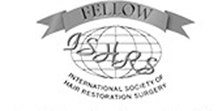Hair Camouflaging Products
Camouflage agents are topical products applied to the hair or scalp to increase visual density of the hair. In general, these agents are matched to the color of the individual’s hair. Camouflage products are used principally for two reasons. First, they can be used to cover existing baldness to delay the need to undergo hair restoration or in anticipation of an upcoming hair transplant. Alternatively, they can be used in the postoperative setting when the transplanted hair can cause postoperative thinning that may be unacceptable (telogen effluvium). Also, they can be used simply to add even more density following a hair transplant in anticipation of a second round of hair transplant.
If you would like to learn if hair camouflaging products are right for you, Call 972-312-8105 or email us to schedule your non-surgical hair consultation. The details of your hair restoration (both the limitations and the benefits in your particular situation) will be explained to you during your non surgical hair consultation with Dr. Lam and his team.
We encourage you to learn more about hair camouflaging agents below:
The two most popular hair camouflaging agents are Toppik and DermMatch.
Toppik is applied to the hair follicles to increase visual density, whereas DermMatch is applied to the scalp to decrease the visibility of the naked scalp.
Toppik (Spencer Forrest, Inc.) is composed of fibers that attach magnetically to the hair, which can be affixed to the hair more tenaciously with additional hair sprays. A disadvantage of fibers is that they can come off easily onto pillows and are slightly messy during application. With light rain, there should not be a problem but a heavy downpour will displace the product. Alternative to Toppik are Super Million Hair, which is manufactured in Japan, and is made of rice keratin as a by-product of sake distillation. It is not available in the United States. Hair Magic (Lookwell, Inc.) consists of rayon fibers and comes in eight colors.
DermMatch (DermMatch, Inc.) is a powder cake that is applied with a wet sponge applicator to the scalp and is advertised as water resistant. It can usually survive light rain but will fail in heavier water situations. It is excellent for applying to focal areas of loss and can be more economical than fibers. However, it takes longer to apply especially with longer hairstyles. DermMatch comes in eight colors.
COUVRe (Spencer Forrest, Inc.) is a lotion consisting of sesame seed emulsion that requires direct application to the scalp. It has the consistency of cream shoe polish and is relatively water resistant.
Sprays like ProTHIK (Aquilia International Ltd.) and Fullmore (Spencer Forrest, Inc.) are easily and quickly applied and are water resistant. However, like fibers they can be messy and cause soiling of clothing and furniture. Inhalation of the agent should be monitored during application.
In general, all of these hair camouflaging products should not be applied until the scabs fall off or are removed on the 7th postoperative day following hair transplant. Although other surgeons may permit earlier use of these products, we are more conservative, as you have invested good money, time and your own limited hair to attain an excellent surgical result.
Although we have no financial bias with any company, we tend to prefer and recommend Toppik in most cases owing to ease and speed of application as well as its efficacy in achieving improved visual density. It also has less interference with the scalp following hair transplantation and also when considering use of topical minoxidil (Rogaine). It is very important that all scalp products (DermMatch, COUVRe) are entirely removed from the scalp before minoxidil application.
Hopefully, this brief guide on adjunctive hair camouflaging agents may be helpful as you plan for your hair transplant or following your hair transplant procedure. For more specific questions regarding your situation, please do not hesitate to contact us.




